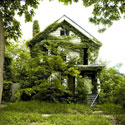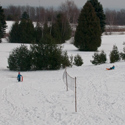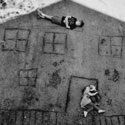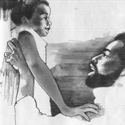I've really backed myself into a corner with these
Terrifying Nixon-era Children's Books, given all my phony captions and snarky commentary. Occasionally now I'll come across a book produced during this era and parts of it will be so strange I'm sure you'll think I made it up, and John Holland's
The Way It Is (Fifteen boys describe life in their neglected urban neighborhood) is just such a book. On its surface, the book isn't all that different from any of the recent "kids with cameras" experiments or even the idea I'm trying to execute
by giving cameras to a bunch of kids on the east side of Detroit. Back in the mid-1960s, a Brooklyn high school teacher gave his students cameras through a grant from Eastman Kodak and they went about photographing their lives in a Williamsburg neighborhood that today only exists in the distant memories of the Puerto Ricans who once lived there. The photographs show street life in a Williamsburg neighborhood just as Johnson's Great Society was taking effect and urban renewal housing projects were replacing the historic slums. The text in the book is supposed to be from the students' perspective, explaining what they captured on film.

I'm sharing this book with you not just because some parts of it are unintentionally funny today (even though they are), but because it remains such a quaint little piece of evidence of how strange the world of children's publishing was in 1969. All of these books show how new psychological and social attitudes filtered down to the media that was being created for kids, where showing them "the truth" (usually through black-and-white documentary photography) was far more important than telling a good story. These books are all earnest and heartfelt and almost universally dull (which I why I have so often made up the captions).

The world this book portrays is as terrifying on the page as it probably was in real life. Junkies attack school kids and push them off rooftops to die after the ambulance doesn't come in time. Feral dogs roam the neighborhood. The streets are filled with bums and drunks. But despite this subject matter, it was clearly intended for a very young
audience. Inside my copy I found a stamp from the library of a suburban
Detroit
elementary school. Who was the book's intended audience? Surely other slum kids didn't need a book like this to show them what was wrong in their neighborhoods. I can only assume the book was intended to show sheltered middle-American kids how terrible life was in the ghetto, perhaps with the intent of spurring them to some sort of activism. Some of the contemporary reactions to the books are telling. Senator Jacob Javits of New York said, "This book will do both---inspire better-positioned boys and girls of all ages to serve and help in the slums and ghettoes---and testify to how unbelievably bad it is but how much can be done!"; Senator Edmund Muskie of Maine said, "If children can get to know each other through this kind of communication, their generation stands an excellent chance of avoiding the fear, mistrust, and lack of understanding that has afflicted our own."
There were similar books published in this era that I also really like (Herb Goro's
The Block; Clifford McElroy's
house with 100 lights) but what makes this one so strange is its intended audience of very young children. I'm going to ignore a large chunk of the book that shows kids skipping class and drinking and sniffing glue in public parks or tenement rooftops, sharing instead a few pages that focus on some of the neighborhood characters the kids encounter, like good old Buck Teeth Joe Junior:
Or good old Uncle Tio. He really likes to play with kids:
[
This post has a lot more pictures from the book, so I'm going to break it up. If you'd like to see the rest of the post, click here]



















































































